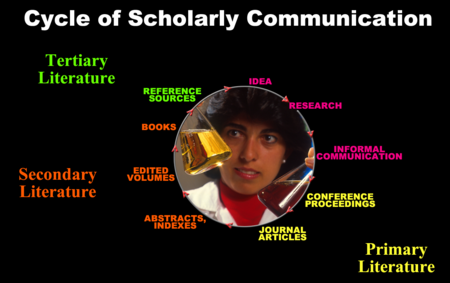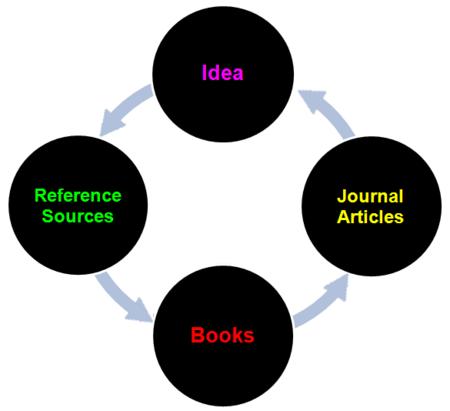Library:Library Research Skills For Biologists/Module 1/Page 01
ARCHIVE PAGE: Aug 2015
How Can I Use This?
Understanding the flow of scholarly communication allows you to place resources you find in context, and decide what types of resources to use in different areas of your research.
While we go through each component of the scholarly communication cycle, we'll examine it through the lens of the discovery of insulin as a treatment for diabetes, a crucial scientific discovery which was discovered and communicated using every part of the cycle.
The Cycle of Scholarly Communication
|
In order to find information, it helps to understand how information is created and published in the first place. Scholarly communication is often discussed in terms of a cycle because reading about a subject area might spark a new idea in the mind of the reader, thus beginning the cycle all over again. Here you can see the cycle of scholarly communication, and it is easy to imagine how ideas are built upon one another. |
| Image Credits:[1] |
Generally, when you are seeking information, especially on an unfamiliar topic, it is often effective to move counter-clockwise around the cycle of scholarly communication.
 |
|
The Story of Insulin
Michael Bliss (1982) [1] says in his book, "Insulin had not emerged out of a vacuum." A half-century of research by scientists around the world had laid the foundation for the discovery of insulin by Banting and Best at the University of Toronto.
By 1920, researchers had established that diabetes mellitus involves the body's inability to metabolize food, especially carbohydrates, and that it is the pancreas that is responsible for this metabolism. Many scientists speculated that it was an internal secretion produced by the islets of Langerhans in the pancreas that held the key to carbohydrate metabolism. So far, experiments to isolate the internal secretion and use it to treat diabetic patients had failed.
- ↑ Bliss, M. 1982. The discovery of insulin. McClelland and Stewart, Toronto, Ont.